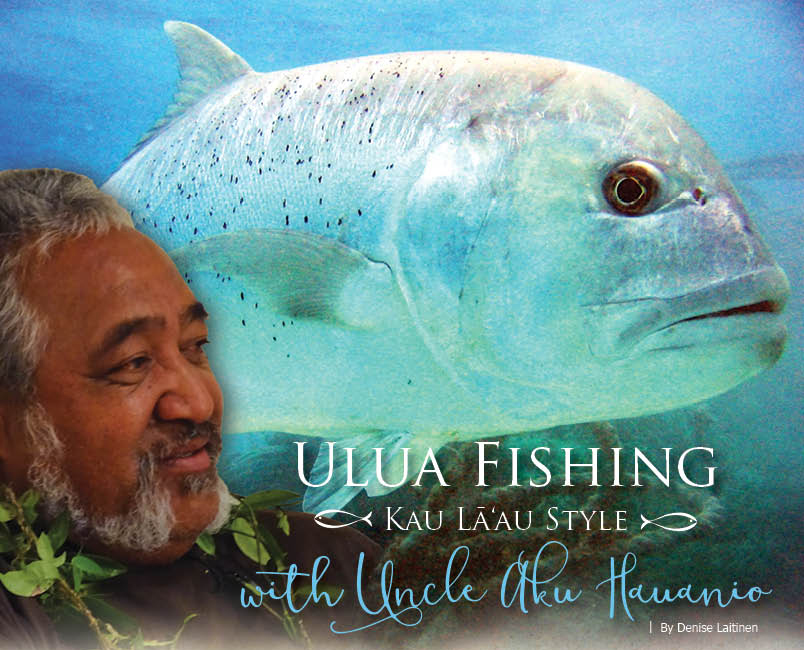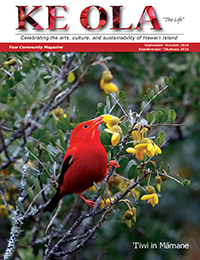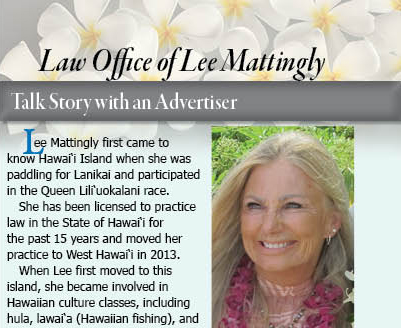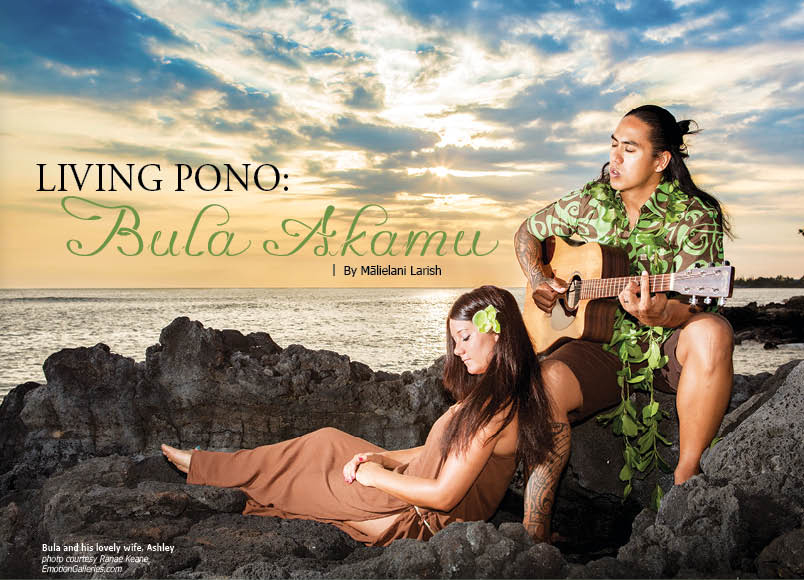
Ulua Fishing Kau Lā‘au Style with Uncle Aku Hauanio
By Denise Laitinen
Fishermen rarely share their secrets, yet Uncle Aku is about to tell me the special ingredient to his fish soup. Not just any soup; soup featuring ulua, the most sought-after shoreline fish in Hawai‘i.
“Coconut milk makes a big difference,” says Clarence Hulihee “Aku” Hauanio, with a twinkle in his eye. A lifelong fisherman, Aku learned how to cook fish from his grandfather, who was born and raised in Kalapana, as were Aku and his father.
“Back then, the old folk would boil the fish head and bone then add garlic and ginger,” says Aku. “Already the ulua is kinda fatty and the coconut milk adds to the flavor,” he says with a big grin.
Such delicious soup is savored and enjoyed down to the last morsel—for its tastiness and also for the effort and planning that went into catching the fish that provided the meal.
Just as Aku cooks his soup the old Hawaiian way, so too he practices a form of ulua fishing that he learned from his grandfather—a style rapidly fading from Hawai‘i’s shorelines.
“Hawaiian-style ulua fishing is different—it’s not like you just wake up and decide to go fishing today,” explains Aku.
Kau lā‘au, traditional Hawaiian ulua fishing, is not for the impatient or faint of heart—or talkative.
Growing up close to the ocean in rural Puna with his four brothers and sisters, Aku spent his youth diving and fishing, living on the ocean’s bounty.
“Everything that the ocean gets to give—nenue (chub fish), ‘opihi (limpets), ‘a‘ama (crab), wana (Hawaiian sea urchin)—we made use of all the resources. I remember seeing so much fish. We were catching all kine: moi (threadfish) to āholehole (endemic fish) to mo‘ilili. If there was no mo‘ilili around, we’d go after ohua (young manini).”
It was the ulua fishing that made the biggest impression on Aku.
“My grandpa and dad would go kau lā‘au fishing. It was pretty wild watching them do this style fishing,” says Aku.

Kau lā‘au fishing involves carrying a fishing pole as tall as a three-story building along a rocky sea cliff, inserting one end of the pole into a lava crack or crevice and dangling the pole over the edge of the cliff. Special bait has to be caught in advance and sewn to the fishing hook (an art form in itself). If a fisherman is lucky enough to catch a fish he must then haul the 30–120 pound fish up a sheer 20–30 foot cliff using two ropes that work as a pulley system. If it sounds simple, it’s not. A lot of planning, skill, and a little luck all factor into kau lā‘au fishing.
One of the first things Aku had to learn was to be quiet. “They [my grandfather and father] didn’t like to take the kids along because after a while we would get restless and start talking and it would scare the fish away. I would go and not say too much, just observe and listen.”
He also observed the tides and the phases of the moon—critical components of fishing during ulua season, which runs for roughly six months of the year from early spring to early fall.
“You gotta go at high tide. If you go at low tide there’s no fish. When the water is real high the fish come in to feed, maybe 10 feet away from the cliffs. You need plenty white water on the inside [close to shore] so the fish cannot see the hook.”
Checking tide calendars, the phase of the moon and weather reports is done days in advance of actually fishing because in order to go fishing, you need bait—and not just any bait.
Aku uses eels as bait when kau lā‘au fishing. Catching the eels can be an adventure in and of itself that takes an hour or more.
“Some days the eels don’t even bite,” adds Aku.
“You go down Pohoiki; you not going to catch anything because the eels will see you coming. If you go Ahalanui you might get some over there.” Like any true fisherman, Aku doesn’t give up the name of his best eel hunting spots.
Once caught, the eels are placed in the freezer and prepared the morning of the fishing trip.
“The front part of the eel is cut up for the chum and the back part is for the hook.”
The eel tail has to be de-boned and then carefully sewn to the large hook using twine, weaving it around the top of the hook so water doesn’t get into the tail of the eel.
“De-boning the eel’s tail makes it nice and soft, which is more attractive to the ulua,” says Aku making a wiggling motion with his arm. “You can really see the difference when you put the baited hook in the water.” He stresses the importance of making sure the top of the hook and fish are sewn tight, “because if water gets into the pockets where the bone used to be it makes the eel stiff again.”
Each fishhook might take anywhere from 45 minutes to an hour to prepare and Aku typically takes four hooks with him on any given fishing trip. At this point, he’s already invested close to five hours into the fishing trip, and he hasn’t even started fishing.
Then there is the fishing gear itself. When kau lā‘au fishing, Aku uses traditional Hawaiian fishing poles made from a single ‘ōhi‘a tree, weighing roughly 75 pounds and more than 30 feet in length. The poles have to be just the right length, the right thickness, and most importantly, forked at the tip. That means lots of time in the forest looking for just the right tree.
“You don’t want them too big,” explains Aku. “The tip needs to be the right size and it needs to be forked, because if not, then the fish won’t bob in the ocean. If the wood is too stiff, it will break. If the pole is too big, it will be too stiff and breaks the fish’s mouth.”
The wood needs to be soft to be flexible—yet not too soft. After finding the right ‘ōhi‘a tree, the bark is removed and the wood is left to dry—preferably under a house or other area where it is not exposed to the sun or rain.
Aku’s current kau lā‘au pole is 33 feet long and is unusual in that the tree forked and then the two branches of the fork grew toward each other. This makes the pole even better for fishing because the ropes used to haul the fish up from the ocean don’t slip out of the “Y” shape at the end of the pole.
Using simple knots to hold them in place, two lines of rope are attached to the pole on either side, which act as a pulley system. A large hook at least six inches long is attached to this pulley system using an additional rope. Aku explains that you want two lines in place in case one of the lines slips out of the fork at the end of the pole. Like the pole, the ropes need to be strong in order to handle the weight of the ulua, which can run more than 100 pounds.
“My grandpa used to use aho (cotton line). Nowadays they only sell the small cotton line used for the rigging of canoes, but we need the bigger lines for this type of fishing. I use nylon line.”
With the poles and lines ready to go and the hooks prepared with the bait, it takes two to three people to carry and set up the long and heavy fishing pole (another reason you have to plan in advance to go fishing is to coordinate everyone’s schedule.)
The cliffs have to be jagged and uneven in order to find a crevice of sufficient size in which to wedge the pole about 8–10 feet from the edge of the cliff. Cliff height is important too.
“Before I even put the hook on my line, I use my line to lower the pole over the edge of the cliff. If the cliff is too high, then it’s harder to haul up the fish.”
“You have to find a hole or crevice to put the end of the pole in and then find rocks to hold it down. The pole needs to set up at an angle too. If you have it flat, the fish will pull the pole right into the ocean.”
Preparing the baited hooks, loading and unloading the heavy fishing poles, carrying them along the rough sea cliffs and getting the poles set up takes a lot of work and effort.
“You have to have two to four people to make it comfortable in what you’re doing because of all that is involved with your hooks and pole. It takes a lot of time to set up.”
Many of the spots Aku and his family have fished over the generations have changed due to Mother Nature. In November 1975, a magnitude 5.7 earthquake, quickly followed by a 7.7 quake, struck just west of Kalapana. The quake, which caused millions of dollars in damage and triggered a tsunami that killed two people, resulted in large swaths of the Puna coastline sinking—in some areas by as much as 10 feet.
“After the coastline sunk during the 1970s, that jammed up some of our fishing areas,” says Aku. “Now the water splashes right on the area where we used to fish.”
His father and uncles found other places to fish ulua, then some of those spots were covered when lava destroyed Kalapana in the 1990s. Aku persevered and found new places along the Puna coastline. Places where he taught his son to kau lā‘au fish, just as his grandfather had taught him.
For all the hard work and effort, Aku says he prefers the old style way when it comes to catching ulua.
“This is better than most other reels and pole fishing—you can bring up a bigger game. It’s different when you fight a fish on this pole than on a regular pole. On a regular pole, the fish is just going to run and run, but on a kau lā‘au fishing pole it’s faster to bring up the fish.”
Sometimes the ulua eat the chum, yet won’t bite the hook. If an ulua gets away, it will come back the next time it sees the fisherman’s hook and scare away the other fish.
“Ulua will become what native Hawaiians call ‘au‘a,” explains Aku. “If a fish bites the hook a certain way, the hook breaks the fish’s jaw and it swims away. The ulua will then come around and chase all the other fish away. I’ve seen that happen lots of time.”
All told, Aku and his fishing companions might spend 8–10 hours fishing, not including the time they spent catching and preparing the bait or preparing the poles. Aku says they rarely leave the sea cliffs empty handed. “We usually always catch something; they come around.”
The prized fish are then dried on rocks. “The bigger uluas are better dried. They’re pretty tasty when dried.”
No part of the fish is wasted though, with the bones and head being used for soup.
Now retired after working for 29 years at Hawai‘i Volcanoes National Park, Aku still goes fishing a couple times a week, although given the strenuous work involved in kau lā‘au fishing, these days you’re more likely to find him in his fishing boat off of Pohoiki.
Yet Aku feels it’s important to teach younger generations, kama‘āina and visitors alike, about traditional Hawaiian fishing methods.
“Nowadays you don’t see anyone doing this style of fishing.”
In order to help perpetuate Hawaiian culture, Aku gives demonstrations across Hawai‘i Island and the state, explaining the art and science of kau lā‘au ulua fishing. If you’re really lucky, he’ll even share his fish soup recipe with you. ❖
Watch Uncle Aku in a video from January 14, 2014 at Puana Ka ‘Ike sponsored by the Keauhou–Kahalu‘u Education Group.
Contact writer Denise Laitinen



